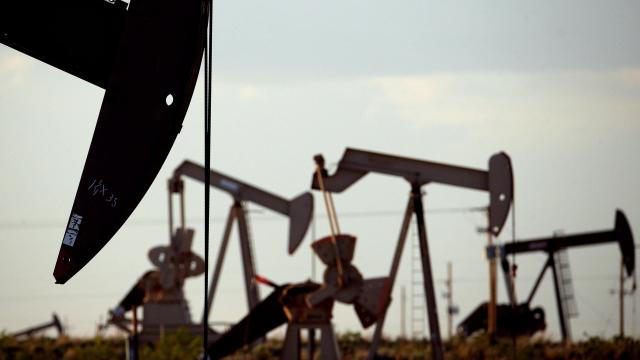This week’s IPCC report laid out in no uncertain terms how little time we have left to get our act together to prevent disastrous global warming. Hidden inside the dense report is a challenge for, of all industries, fossil fuel producers: Step up your game on methane.
Methane, which is much more intense a greenhouse gas than carbon dioxide but stays in the atmosphere for a much shorter amount of time, is a new alarm bell for the Intergovernmental Panel on Climate Change, which has traditionally focused on the longer-term impacts of CO2. But as fires, floods, and storms get more intense and destructive each year, the need to reduce methane is clear.
“Methane provides a short-term win,” Drew Shindell, chair of the Climate and Clean Air Council Science Advisory Committee and professor of climate science at Duke University, said during a press conference Tuesday. “Unlike CO2, which stays in the atmosphere for hundreds of years, methane lives for about a decade in the atmosphere. When we reduce it, we can rapidly slow warming. It’s urgent to get going quickly on methane, because the impacts of climate change are accelerating.”
The IPCC report released this week gives us some concrete targets: To keep warming to 1.5 degrees Celsius (2.7 degrees Fahrenheit), methane emissions need to fall 34% by the end of this decade, in conjunction with big reductions in CO2.
“We know what we have to do,” Shindell said.
Compared to all the major societal shifts we need in order to prevent catastrophic warming, righting the ship on methane is relatively simple. One of the biggest sources of methane is from the production of fossil fuels; nearly a third of the world’s methane emissions are from that sector, and many of those emissions are fugitive, meaning gas that is leaked, burned, or accidentally lost during the production process. And we’ve actually got solutions to fix a good chunk of those emissions. The IPCC report estimates that 50% to 80% of these emissions could be fixed using existing technologies — which, by the way, would also provide financial benefits to fossil fuel producers, since they could sell gas that would otherwise be lost. In recent years, the industry has paid a lot of lip service to fixing its methane problem. Seems like a win-win!
Unfortunately, what the oil and gas industry says it’s doing doesn’t line up with its actions. The American Petroleum Institute, the lobbying arm for the industry, campaigned hard last year against a provision in the Build Back Better Act that would have put a fee on oil and gas producers who exceed a certain threshold for methane emissions. API and other industry groups argued that the government should play nice with fossil fuel producers and not impose any scary fees to fix the industry’s methane problem. Given that an analysis published earlier this year estimated that worldwide methane emissions from fossil fuel production are up to 70% higher than official estimates, the industry dragging its feet on methane now is especially dangerous.
According to the International Energy Agency, the U.S. is the third-largest emitter of methane worldwide. In Texas’s Permian Basin, one of the world’s largest oil and gas producing regions, just over 100 sites are responsible for enormous methane leaks, a study last year found. Another recent analysis found that the state’s regulatory body for oil and gas, the Texas Railroad Commission (RRC), lets a lot of flaring — a process of dumping or burning unwanted gas into the atmosphere — go un-permitted, meaning that producers have carte blanche to release as much methane as they want. Last summer, the RRC, which has deep ties to the oil and gas industry and climate deniers at its helm, sent a letter to the EPA complaining about the Biden administration’s plans to regulate methane.
“I like to say that we don’t have to have a regulation, or a rule, or a law for oil and gas companies to do the right thing — they could step out and do that today,” said Don Schreiber, a rancher in New Mexico. “They could step right up and fix these leaks.” Schreiber, on the same press call as Shindell, was standing in front of one of 122 wells on his property; he described how he’s been filming methane leaks on his property since 2015, with little to no response from producers in plugging the wells.
“I can’t get any methane shutdown through a mission statement, through some sort of phase-in promises or corporate speeches,” he said. “No corporate mission statement stops any oil and gas. They’ve got pumpers in the field. They could go out and start fixing those leaks today. They have all the tools they need.”
While the industry twiddles its thumbs, methane is on the rise in a scary way. In 2020, while we were mostly stuck inside, methane levels shot up 14.7 parts per billion — compared to 8.5 ppb in 2018 and 10.7 ppb in 2019. There are some signs that regulation and attention is having a positive impact, and there’s been some movement internationally to get the world on track to halt emissions. But the oil and gas industry can and should be doing more.
Fossil fuel companies love to pitch themselves as part of the climate solution. So, oil execs, here’s a challenge: If you really want to help, start arguing for regulations, for increased monitoring and outside interference, to help solve this incredibly easy problem. And fix those leaking wells now.
